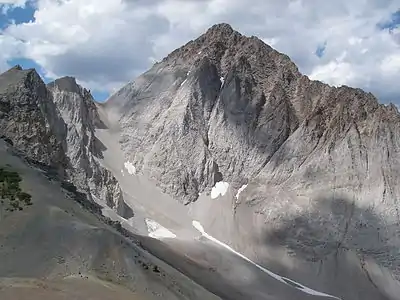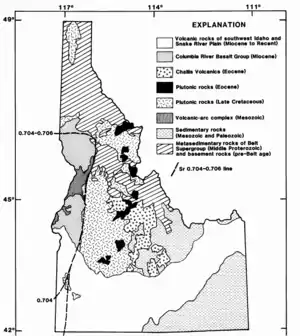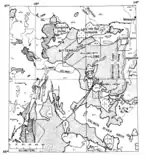Idaho Batholith
The Idaho Batholith is a granitic and granodioritic batholith of Cretaceous-Paleogene age that covers approximately 25,000 square kilometres (9,700 sq mi) of central Idaho and adjacent Montana. The batholith has two lobes that are separated from each other geographically and geologically. The smaller Bitterroot lobe in the north is separated from the larger Atlanta lobe in the south by the Belt Supergroup metamorphic rocks that compose the Salmon River Arch. The Bitterroot lobe is 75 to 53 million years old, and the Atlanta lobe is 98 to 68 million years old.[1][2] A separate and unrelated igneous center, the Kaniksu batholith, is present in the Idaho Panhandle but is generally older (~primarily 120 to 100 million years old with a limited number of younger Cretaceous components).[3] Much of the Atlanta and Bitterroot lobes are in the Idaho Batholith ecoregion while the Kaniksu batholith is in the Northern Rockies ecoregion.[4]

References
- Foster, D.A.; Fanning, C.M. (1997). "Geochronology of the northern Idaho Batholith and the Bitterroot metamorphic core complex: magmatism preceding and contemporaneous with extension". Geological Society of America Bulletin. 109: 379–394. doi:10.1130/0016-7606(1997)109<0379:GOTNIB>2.3.CO;2.
- Gaschnig, R.M.; Vervoort, J.D.; Lewis, R.S.; McClelland, W.C. (2010). "Migrating magmatism in the northern US Cordillera: in situ U–Pb geochronology of the Idaho batholith". Contributions to Mineralogy and Petrology. 159: 863–883. doi:10.1007/s00410-009-0459-5.
- Gaschnig, R.M.; Vervoort, J.D.; Lewis, R.S. (2012). "The Kaniksu and Idaho batholiths, northern U.S. Cordilleran: close relatives or a case of mistaken identity?". Abstracts with Programs - Geological Society of America. 44: 383.
- "Ecoregions of Idaho" (PDF). U.S. Environmental Protection Agency. Retrieved December 22, 2014.

